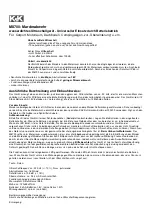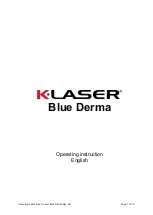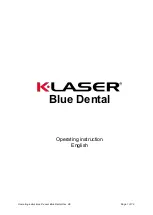
TMM-310
Guidelines for RO cleaning
TORAY REVERSE OSMOSIS ELEMENTS section page:
1
/
2
Operation, Maintenance and Handling Manual rev.: 105
v
ersion: October 2012
Guidelines for RO cleaning
When to clean:
For best efficiency of cleaning procedure, elements must be cleaned before
fouling has fully developed. If cleaning is postponed for too long, it will be
difficult or impossible to completely remove foulants from the membrane surface
and re-establish full performance.
Commence cleaning when
1.
Normalized differential pressure increases more than 20%
OR
2. normalized permeate flow rate decreases by more than 10 %
OR
3. normalized salt passage increases by more than 20 %.
Weighing an element is an easy check for the occurrence of fouling. If the
weight of the element is much higher than that of new element, fouling has
occurred. Before weighing the element, stand it vertically on a perforated plate
or drain for 60 minutes to allow drainage of fluids.
The approximate weight of new elements (drained condition) are:
x
4 inch diameter x 40 inch long: 4Kg,
x
8-inch diameter x 40 inch long (400ft2 membrane area): 15Kg
x
8-inch diameter x 40 inch long (440ft2 membrane area): 16 kg
Determination of foulant type
It is important to determine the type of foulants on the membrane surface before
cleaning. The best approach for this is a chemical analysis of residues collected
with a membrane filter during an SDI15 value determination for pretreated water.
In situations where chemical analysis is not available, it is often
possible to classify foulants by color and consistency of residue on
the membrane filter. A brownish color residue will typically indicate
iron fouling. White or beige color typically indicates silica, loam,
calcium scale, or biological fouling. Crystalline constitution is a
feature of calcium scale or inorganic colloids. Bio-fouling or organic
material will – besides the smell - often show slimy/sticky
consistency.
Page 62
Coral Sea Owner's Manual
Page 22 of 24
Summary of Contents for Coral Sea
Page 3: ...SECTION 1 SYSTEM DESCRIPTION Coral Sea Owner s Manual...
Page 14: ...SECTION 2 PRE INSTALLATION NOTES Coral Sea Owner s Manual...
Page 25: ...SECTION 3 ELECTRICAL INFORMATION Coral Sea Owner s Manual...
Page 28: ...SECTION 4 INSTALLATION REQUIREMENTS Coral Sea Owner s Manual...
Page 35: ...SECTION 5 OPERATIONS MANUAL Coral Sea Owner s Manual...
Page 36: ...Operation THIS PAGE INTENTIONALLY LEFT BLANK Coral Sea Owner s Manual...
Page 166: ...Intentionally Left Blank Coral Sea Owner s Manual...
Page 167: ...SECTION 6 R O MEMBRANE INSTALL CARE Coral Sea Owner s Manual...
Page 193: ...SECTION 7 MAINTENANCE AND REPAIR Coral Sea Owner s Manual...
Page 194: ...Maintenance Coral Sea Owner s Manual...
Page 203: ...SECTION 8 COMPONENT USER MANUALS Coral Sea Owner s Manual...
Page 204: ...Page Intentionally Left Blank Coral Sea Owner s Manual...
Page 215: ...SECTION 9 DRAWING PULL OUTS Coral Sea Owner s Manual...
Page 216: ...Page Left Intentionally Blank Coral Sea Owner s Manual...
Page 247: ...SECTION 10 SPARE PARTS LIST Coral Sea Owner s Manual...
















































